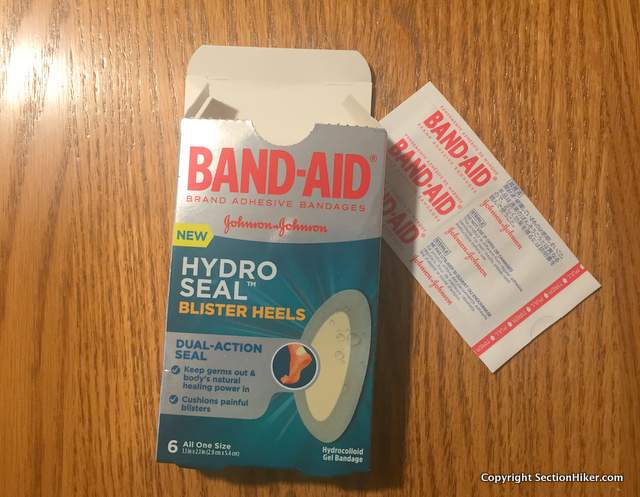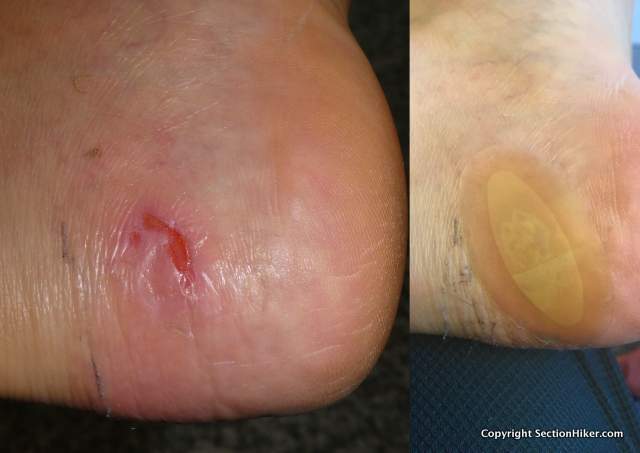
Band-Aid Hydro-Seal Blister Bandages are hydrocolloid gel bandages that are the state-of-the-art for modern wound care. They’re very sticky and waterproof, so you leave them on until they fall off, usually after 3-5 days. You can even shower with them on or do a stream crossing. They’re designed to be used by themselves, without the use of extra antibiotic ointment. They work by completely sealing off the wound area from germs and letting your body’s immune system heal the wound.
These hydrocolloid gel bandages provide a moist healing environment while using the body’s moisture and enzymes to keep the wound hydrated for proper wound healing. They don’t adhere to the wound, only the surrounding skin, thereby keeping healed skin intact. They also stay on for days at a time, minimizing any disruption to the healing tissue, caused by frequent bandage changes.
While blister prevention, for example using Leukotape, is always preferable, these Hydro-Seal Bandages are the ticket for SHTF wound care after the damage has been done. They’re available in multiple sizes and intended for use as-is, without any additional shaping or trimming. Each bandage is sterile and latex-free, making them good for people who have a latex allergy. They’re also surprisingly inexpensive and you might even consider carrying one or two in your first-aid kit.
- Heel sized blister bandages
- Toe-sized blister bandages
- Corn cushion bandages
- Finger-sized wound bandages
- Medium-sized, general purpose wound bandages
- Large-sized wound bandages
To use a Hydro-Seal Bandage, clean and dry the affected area of your foot (or body part). It is important that they wound be uninfected and sterile before covering it with the bandage because it forms an air-tight seal over it. Apply the bandage to the blister or wound, being careful to keep the adhesive edges off the afflicted area. Rub your thumb around the edges to seal ensure a tight waterproof seal. After 24 hours, the center of the bandage will plump up a bit, which indicates that the healing process has begun.

You can use a Band-Aid Hydro-Seal Bandage on popped or un-popped blisters. If a blister is painful, I usually pop a blister with a sterile needle and drain the fluid inside, being careful to keep the skin on top intact because it prevents infection and accelerates healing. The fluid build-up is often the source of the pain and removing it can make you more comfortable, especially if you plan to keep walking on it. You can also cushion the bandages more by building a moleskin ring around them, but you need to be careful to keep the moleskin off the bandage to prevent tearing it off the wound when you remove it.
The exterior of these Hydro-Seal Bandages is very slick, which cuts down on friction inside your shoes if you plan to keep walking with your blister. The marvelous thing about these bandages is you can continue hiking, even if you have a bad blister, after applying them. The gel in the bandage absorbs the fluid that leaks out of a wound or blister (called “exudate”) as it heals. This keeps the wound moist and pliable, which helps to dramatically reduce the pain of walking.
Band-Aid Hydro-Seal Bandages are not recommended for use over stitches, burns, fragile skin, deep puncture wounds, or infected area. Diabetics and people with poor circulation should also consult a medical authority before use. But for hiking and backpacking blisters, I have to say that these blister bandages are the BEES KNEES! Highly recommended.
SectionHiker is reader-supported. We only make money if you purchase a product through our affiliate links. Help us continue to test and write unsponsored and independent gear reviews, beginner FAQs, and free hiking guides. SectionHiker.com Backpacking Gear Reviews and FAQs
SectionHiker.com Backpacking Gear Reviews and FAQs